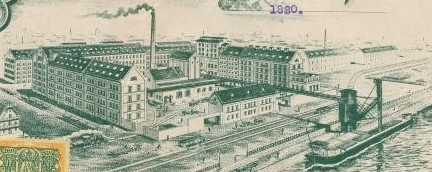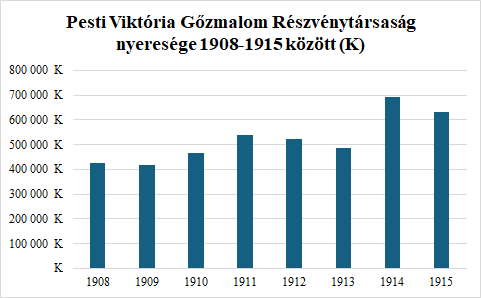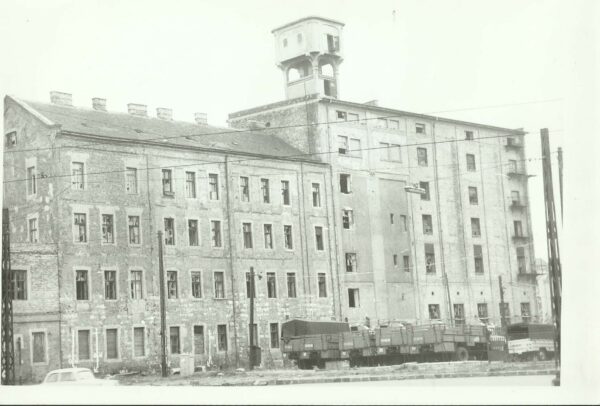Pesti Victoria Steam Mill

The history of the steam mills is intertwined with the history of the capital: although the steam mills were established before the unification of Buda, Pest and Óbuda in 1873, their development was influenced by the development of the capital and its economic role. The establishment of the steam mills was made possible by the favourable transport conditions created by the Danube steamship and the agricultural boom in the middle of the century, which resulted from the urbanisation of European cities. Population growth led to a greater demand for grain, which meant that there was also an adequate outlet for it. The succession of steam mills had the advantage of being steam-driven, allowing them to be sited freely, as they did not need water or wind to operate. However, the steam engine required a considerable amount of water to operate the steam mills, which is why they were built close to the Danube.
The so-called "high milling" method, which was widespread in Hungary, was as follows: the grain was first taken from the warehouse to the mill, where it was cleaned of major impurities and the husk in the milling machine. The task of the 'tarar' was to clean the wheat grain before it went to the wheat classifier, which was able to sift out the defective grains. The thresher was responsible for filtering out the kernels and the brushing machine for removing the dust. The last operation before milling was conditioning, during which water equivalent to 2-3% of the weight of the wheat grains was added to the wheat. This was followed by a resting period and then the cleaned wheat was subjected to repeated crushing to obtain a fine flour. To obtain a larger grain size, it was milled into flour using roller mills or roller pairs.
The Viktoria Steam Mill in Pest was founded by the timber merchant Lord Samuel in 1866. The building is located on the site surrounded by today's Újpest quay, Tutaj Street, Kárpát Street and Bessenyei Street. The mill was bought by the Victoria Steam Mill Joint Stock Company in 1867
In the early 1880s, the Victoria steam mill in Pest, like the other mills, also faced difficulties. The rise in wheat prices and the loss of exports to Germany caused the mill to cease operations for part of the year. Cheap American grain added to the difficulties, and the mill continued to operate at a loss in the first half of the decade. In the middle of the decade, technical improvements were made by the management in order to reduce production costs. The difficulties encountered in the first half of the decade are clearly reflected in the volume of production in terms of honey production:
- 1878: 378142 mm
- 1879: 350730 mm
- 1880: 304082 mm
- 1881: 296093 mm
- 1882: 334478 mm
- 1884: 233510 mm
In 1891, the company bought the Ligeti mill in Szeged and established the Szeged Victoria Steam Mill Company to control it. On 12 January 1896, the Victoria mill in Szeged burnt down, and the company sold it to the Back Bernát sons company. At the end of the 1890s, improvements were again made to increase production: the mill underwent a complete overhaul in 1898 by the firm of Wörner and Partners.
Even at the turn of the century, the evening shutdown was not unprecedented. It was not possible to export surplus flour without the mill making a profit. The flow of foreign wheat to Austria and Hungary forced the mill's management to shut down again. In 1902 an electric elevator was installed to allow grain shipments to be loaded on the Danube.
The mill's heyday dates back to the 1910s, when the company was able to cope well with the disadvantages of foreign competition, to the extent that it was able to increase its profits even in the face of the constraints of the First World War (restrictions on grain purchases).

After the First World War, a number of factors reduced the possibilities for competitive production. This was partly due to the loss of mills in the territories lost under the Treaty of Trianon and partly to the dramatic decline in the market for their absorption. Hungarian mills lost their remaining advantage over foreign competitors. The domestic absorption market has also shrunk significantly, and the lack of modernisation has led to a sharp decline in flour quality.
The importance of the mill, which was slowly recovering from the First World War, is shown by the fact that before the peace treaty the company had a significant potential in the domestic milling industry. Around 1920, its interests included ten provincial joint-stock companies, as follows: Czeglédi hengermálom, Hungária-gőzmalom in Szolnok, Czeglédi Hunnia-gőzmalom, József-gőzmalom in Kecskemét, Halasi gazdasági gőzmalom, Bajai hengermalom, kiskunfélegyháza Krausz-hengermalom Részvénytársaság, Csongrádi hengermalom és gampffähész Részvénytársaság, hódmezővásárhelyi Bauer-malom Részvénytársaság, Szegedi mezőgazdaságiindustrie Részvénytársaság. In addition, it had ten mills operating in the area beyond the border after the Treaty of Trianon: United László and Hunyadi Steam Mills of Oradea, Timisoara Steam Mill, Ludvig Gottfried Steam Mill Joint Stock Company of Bratislava, Ludvig Gottfried Steam Mill Joint Stock Company of Bratislava, Subotica Steam Mill, Bajmok Steam Mill, First New Voivodship Rolling Steam Mill, Upper Bačka Steam Mill Joint Stock Company, Beszterczebánya Rolling Mill. The company also acquired a stake in a foreign company (Sarajevoer Walzmühl A.-G.).
An important factor in the development of problems in the milling industry in general in the first half of the 1920s was the fact that until 1924 the grain and flour market had been under administrative control since World War I (grain distribution was handled by the War Produce Corporation). The main problem was that the Hungarian government had banned futures transactions to avoid further food price inflation. Thus, when the ban on grain exports was lifted in 1925, the mills could not reduce the risk of wheat price movements on the Budapest Stock Exchange by means of futures. For this reason, the company's management decided to open futures on the foreign stock exchange, but this led to a sudden crisis: when prices rose instead of fell, the domestic mill subsidiaries suffered huge losses. This was compounded by the fact that the mill had accumulated substantial debts by then.
The crisis was solved by the intervention of the central bank, which settled the company's debts and then liquidated the company. The reason for the state intervention was, on the one hand, that Pesti Viktória Gőzmalom had previously been actively involved in economic stabilisation, and the state wanted to compensate for this. On the other hand, there was a fear that a possible economic collapse would deter foreign investors from Hungary.
After the events, in March 1926, a prosecutor's investigation was launched against Emil Bacher, who was arrested in June 1926 on the charge of having harmed the company's shareholders through "criminal speculation". Emil Bacher died of a heart attack in 1926. The company was wound up on 30 April 1931. The buildings, once used as a mill, were used as warehouses until the early 1970s, when they were demolished.

Lord Samuel, a timber merchant, founded the mill in 1866 for speculative purposes, which was bought by Victoria Steam Mill Ltd in 1867.Subsequently, in 1898, the company Wörner J. and Partners renovated it using the latest milling technology, and in 1902 an electric elevator was installed to load grain shipments on the Danube. In the mid-1920s, the Pesti Victoria Steam Mill included nine other mills in the countryside and ten in the successor states, but at the end of 1925 it became insolvent and was liquidated in 1931. The mill ceased to be a milling site in the 1930s and was later used as a warehouse, finally demolished around 1972.
Sources
Judit Klement (2010). The Budapest mill industry in the 19th-20th centuries. Budapest.
Klement, Judit (2012): domestic entrepreneurs in the golden age. Entrepreneurs of the Budapest Steam Mill Industry in the Second Half of the 19th Century. Budapest.
Klement, Judit (2023) Budapest and the mills, 1841-2008.Történelmi Szemle 65. 1. 155-167.
Great Hungarian Compass 1876-1926.
Ágnes Pogány (2003) The collapse of the Victoria Steam Mill in Pest. Coral 14. 98-116.
Ágnes Pogány (2000): 'War Produce Corporation'. In Jolán Szijj - István Ravasz. Budapest, Petit-Real.
Press material 1876-1926.
Victoria Steam Mill. Online website: https://hu.museum-digital.org/object/870441?navlang=hu. Last download date: 23 November 2024.
Date of foundation: 1866
Date of cessation: 1928
Founders:Lord Samuel
Securities issued:
| Pesti Victoria Steam Mill |
Decisive leaders:
1867-1875 | Mihály Mannaberg |
1876-1905 | Duke Rudolf |
1906- | exchanges with Péter Herzog |
-1925 | Emil Bacher |
Main activity: cereal milling (wheat, barley, rye)
Seats:
1874-1878 | Budapest Feldunasor |
1879-1885 | Budapest Újpest rakpart 22. |
1886-1905 | Budapest V. Felső-rakpart 22. |
1906-1925 | Budapest V. Újpest rakpart 22. |
Author: Róbert Szabó
Date of foundation: 1866
Founders:Lord Samuel
Decisive leaders:
1867-1875 | Mihály Mannaberg |
1876-1905 | Duke Rudolf |
1906- | exchanges with Péter Herzog |
-1925 | Emil Bacher |
Main activity: cereal milling (wheat, barley, rye)
Main products are not set
Seats:
1874-1878 | Budapest Feldunasor |
1879-1885 | Budapest Újpest rakpart 22. |
1886-1905 | Budapest V. Felső-rakpart 22. |
1906-1925 | Budapest V. Újpest rakpart 22. |
Locations are not set
Main milestones are not set
Author: Róbert Szabó
Pesti Victoria Steam Mill

The history of the steam mills is intertwined with the history of the capital: although the steam mills were established before the unification of Buda, Pest and Óbuda in 1873, their development was influenced by the development of the capital and its economic role. The establishment of the steam mills was made possible by the favourable transport conditions created by the Danube steamship and the agricultural boom in the middle of the century, which resulted from the urbanisation of European cities. Population growth led to a greater demand for grain, which meant that there was also an adequate outlet for it. The succession of steam mills had the advantage of being steam-driven, allowing them to be sited freely, as they did not need water or wind to operate. However, the steam engine required a considerable amount of water to operate the steam mills, which is why they were built close to the Danube.
The so-called "high milling" method, which was widespread in Hungary, was as follows: the grain was first taken from the warehouse to the mill, where it was cleaned of major impurities and the husk in the milling machine. The task of the 'tarar' was to clean the wheat grain before it went to the wheat classifier, which was able to sift out the defective grains. The thresher was responsible for filtering out the kernels and the brushing machine for removing the dust. The last operation before milling was conditioning, during which water equivalent to 2-3% of the weight of the wheat grains was added to the wheat. This was followed by a resting period and then the cleaned wheat was subjected to repeated crushing to obtain a fine flour. To obtain a larger grain size, it was milled into flour using roller mills or roller pairs.
The Viktoria Steam Mill in Pest was founded by the timber merchant Lord Samuel in 1866. The building is located on the site surrounded by today's Újpest quay, Tutaj Street, Kárpát Street and Bessenyei Street. The mill was bought by the Victoria Steam Mill Joint Stock Company in 1867
In the early 1880s, the Victoria steam mill in Pest, like the other mills, also faced difficulties. The rise in wheat prices and the loss of exports to Germany caused the mill to cease operations for part of the year. Cheap American grain added to the difficulties, and the mill continued to operate at a loss in the first half of the decade. In the middle of the decade, technical improvements were made by the management in order to reduce production costs. The difficulties encountered in the first half of the decade are clearly reflected in the volume of production in terms of honey production:
- 1878: 378142 mm
- 1879: 350730 mm
- 1880: 304082 mm
- 1881: 296093 mm
- 1882: 334478 mm
- 1884: 233510 mm
In 1891, the company bought the Ligeti mill in Szeged and established the Szeged Victoria Steam Mill Company to control it. On 12 January 1896, the Victoria mill in Szeged burnt down, and the company sold it to the Back Bernát sons company. At the end of the 1890s, improvements were again made to increase production: the mill underwent a complete overhaul in 1898 by the firm of Wörner and Partners.
Even at the turn of the century, the evening shutdown was not unprecedented. It was not possible to export surplus flour without the mill making a profit. The flow of foreign wheat to Austria and Hungary forced the mill's management to shut down again. In 1902 an electric elevator was installed to allow grain shipments to be loaded on the Danube.
The mill's heyday dates back to the 1910s, when the company was able to cope well with the disadvantages of foreign competition, to the extent that it was able to increase its profits even in the face of the constraints of the First World War (restrictions on grain purchases).

After the First World War, a number of factors reduced the possibilities for competitive production. This was partly due to the loss of mills in the territories lost under the Treaty of Trianon and partly to the dramatic decline in the market for their absorption. Hungarian mills lost their remaining advantage over foreign competitors. The domestic absorption market has also shrunk significantly, and the lack of modernisation has led to a sharp decline in flour quality.
The importance of the mill, which was slowly recovering from the First World War, is shown by the fact that before the peace treaty the company had a significant potential in the domestic milling industry. Around 1920, its interests included ten provincial joint-stock companies, as follows: Czeglédi hengermálom, Hungária-gőzmalom in Szolnok, Czeglédi Hunnia-gőzmalom, József-gőzmalom in Kecskemét, Halasi gazdasági gőzmalom, Bajai hengermalom, kiskunfélegyháza Krausz-hengermalom Részvénytársaság, Csongrádi hengermalom és gampffähész Részvénytársaság, hódmezővásárhelyi Bauer-malom Részvénytársaság, Szegedi mezőgazdaságiindustrie Részvénytársaság. In addition, it had ten mills operating in the area beyond the border after the Treaty of Trianon: United László and Hunyadi Steam Mills of Oradea, Timisoara Steam Mill, Ludvig Gottfried Steam Mill Joint Stock Company of Bratislava, Ludvig Gottfried Steam Mill Joint Stock Company of Bratislava, Subotica Steam Mill, Bajmok Steam Mill, First New Voivodship Rolling Steam Mill, Upper Bačka Steam Mill Joint Stock Company, Beszterczebánya Rolling Mill. The company also acquired a stake in a foreign company (Sarajevoer Walzmühl A.-G.).
An important factor in the development of problems in the milling industry in general in the first half of the 1920s was the fact that until 1924 the grain and flour market had been under administrative control since World War I (grain distribution was handled by the War Produce Corporation). The main problem was that the Hungarian government had banned futures transactions to avoid further food price inflation. Thus, when the ban on grain exports was lifted in 1925, the mills could not reduce the risk of wheat price movements on the Budapest Stock Exchange by means of futures. For this reason, the company's management decided to open futures on the foreign stock exchange, but this led to a sudden crisis: when prices rose instead of fell, the domestic mill subsidiaries suffered huge losses. This was compounded by the fact that the mill had accumulated substantial debts by then.
The crisis was solved by the intervention of the central bank, which settled the company's debts and then liquidated the company. The reason for the state intervention was, on the one hand, that Pesti Viktória Gőzmalom had previously been actively involved in economic stabilisation, and the state wanted to compensate for this. On the other hand, there was a fear that a possible economic collapse would deter foreign investors from Hungary.
After the events, in March 1926, a prosecutor's investigation was launched against Emil Bacher, who was arrested in June 1926 on the charge of having harmed the company's shareholders through "criminal speculation". Emil Bacher died of a heart attack in 1926. The company was wound up on 30 April 1931. The buildings, once used as a mill, were used as warehouses until the early 1970s, when they were demolished.

Lord Samuel, a timber merchant, founded the mill in 1866 for speculative purposes, which was bought by Victoria Steam Mill Ltd in 1867.Subsequently, in 1898, the company Wörner J. and Partners renovated it using the latest milling technology, and in 1902 an electric elevator was installed to load grain shipments on the Danube. In the mid-1920s, the Pesti Victoria Steam Mill included nine other mills in the countryside and ten in the successor states, but at the end of 1925 it became insolvent and was liquidated in 1931. The mill ceased to be a milling site in the 1930s and was later used as a warehouse, finally demolished around 1972.
Sources
Judit Klement (2010). The Budapest mill industry in the 19th-20th centuries. Budapest.
Klement, Judit (2012): domestic entrepreneurs in the golden age. Entrepreneurs of the Budapest Steam Mill Industry in the Second Half of the 19th Century. Budapest.
Klement, Judit (2023) Budapest and the mills, 1841-2008.Történelmi Szemle 65. 1. 155-167.
Great Hungarian Compass 1876-1926.
Ágnes Pogány (2003) The collapse of the Victoria Steam Mill in Pest. Coral 14. 98-116.
Ágnes Pogány (2000): 'War Produce Corporation'. In Jolán Szijj - István Ravasz. Budapest, Petit-Real.
Press material 1876-1926.
Victoria Steam Mill. Online website: https://hu.museum-digital.org/object/870441?navlang=hu. Last download date: 23 November 2024.